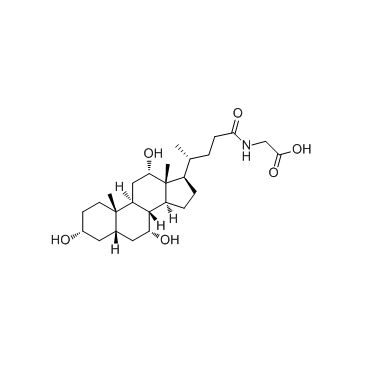Glycocholic acid (Synonyms: Cholylglycine, GCA) |
| Catalog No.GC34134 |
A glycine-conjugated form of cholic acid
Products are for research use only. Not for human use. We do not sell to patients.

Cas No.: 475-31-0
Sample solution is provided at 25 µL, 10mM.
Glycocholic acid is a bile acid with anticancer activity, targeting against pump resistance-related and non-pump resistance-related pathways.
Glycocholic acid (GC) increases the cytotoxicity of epirubicin, significantly increases the intracellular accumulation of epirubicin in Caco-2 cells and the absorption of epirubicin in rat small intestine, and intensified epirubicin-induced apoptosis. Glycocholic acid and epirubicin significantly reduce mRNA expression levels of human intestinal MDR1, MDR-associated protein (MRP)1, and MRP2; downregulate the MDR1 promoter region; suppress the mRNA expression of Bcl-2; induce the mRNA expression of Bax; and significantly increase the Bax-to-Bcl-2 ratio and the mRNA levels of p53, caspase-9 and -3. A combination of anticancer drugs with Glycocholic acid can control MDR via a mechanism that involves modulating P-gp and MRPs as well as regulating apoptosis-related pathways[1].
[1]. Lo YL, et al. Inhibit multidrug resistance and induce apoptosis by using glycocholic acid and epirubicin. Eur J Pharm Sci. 2008 Sep 2;35(1-2):52-67.
Average Rating: 5 (Based on Reviews and 8 reference(s) in Google Scholar.)
GLPBIO products are for RESEARCH USE ONLY. Please make sure your review or question is research based.
Required fields are marked with *




















